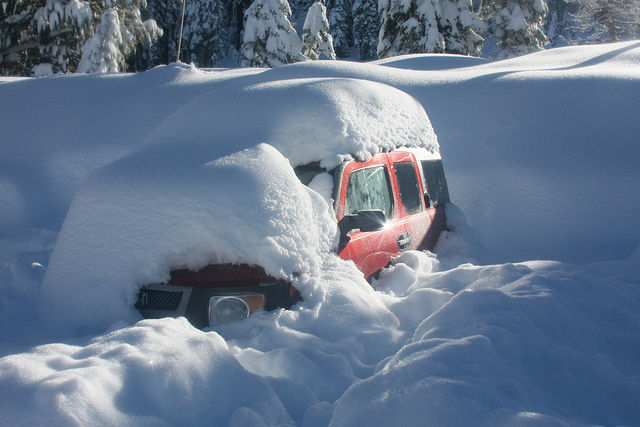Meteorologists have given it a new name — “Polar Vortex.” A new name, but it’s the same old Arctic blast of frigid air that every winter comes across Canada across Lake Michigan picking up moisture and energy all the way.
Every year on the coldest days the Chicago papers and Internet send their photographers out to get pictures of strangely dressed humans exiting Union Station and lunging into the wind as they rush to their stores and offices — hoping to get there before they freeze. And leaving a cloud of frozen breath behind them.
I’ve been there; done that. For 35 years I commuted to work in or near Chicago, winter and summer, in cold or heat in various ways — 10 miles each way by car, 30 miles by car and train or 60 miles by car and bus. And I always dressed for the weather as well as the job. I dressed not for the routine trips but for the emergencies: the flat tire, the dead battery, the car buried in snow at the parking lot, the stalled train, the disabled bus.
Dressing for hot weather is easy. Peel, just stay decent. Dressing for extreme cold is more of a challenge. Many people simply put on all their winter gear. They look as if they are going ice fishing — in Hudson Bay. Fur-lined parkas are always fashionable. Look at the pictures of Chicagoans these winter days. They are pretty good evidence that protection from the cold, not fashion, dictates what is worn.
I chose to dress conventionally — much like I imagined a Siberian envoy would dress. I wore a crown hat of Persian lamb wool — the kind that aged nicely and was handed down from father to son. It had a quilted liner and a band inside that could be folded down to cover my ears and the back of my neck. I had a fur-lined (fake fur) herringbone-patterned wool overcoat that reached below my knees. It had a huge collar that I could turn up to cover most of my head. A wool muffler blocked any cold air that leaked through buttonholes or the like. Fur-lined gloves and 10-inch overshoes completed my outfit.
Inside all of that outerwear my clothes were pretty ordinary: suit, shirt and tie, because once you got there the office temperature was a warm 72 degrees. Rarely did I dig to the bottom of the drawer and come up with underwear suitable for hunting or skiing, because it had to be removed when I arrived or I would have roasted.
As I said, you had to dress for the breakdowns. Some of the worst breakdowns for me were:
Once on the 55-mile bus trip from northern Indiana to our Naperville research center west of Chicago, our usually dependable bus broke down. We were on the Illinois Tollway when the bus quit. The bus made it to the side of the road, and we began waiting for a replacement bus. Outside it was 10 degrees and windy. We could see a service center about a quarter-mile away. At first we stayed with the bus, but as it got colder we got off and walked along the shoulder into the wind to the service center restaurant. It was a nasty hike, but I had dressed well and stayed warm.
When I worked in the Chicago Loop most of my commuting involved taking the electric train (the “Yellow Rattler”) that ran from South Bend to the Loop. On the way home one winter day, the train stopped out in the middle of nowhere — somewhere west of Hegewisch! The conductor said that he was afraid that it would be a long time before power would be restored. It was 5:30 p.m., already dark and cold, and most of us did not fancy waiting there to be rescued. A hundred or more of us chose to get off and walk along the tracks to the nearest major street — Torrance Avenue.
Once this mob of passengers came stumbling out of the dark and gathered along the road, lots of friendly motorists stopped to pick us up. Three of us hopped into the car of a Good Samaritan who drove us to our station (where our cars were parked) at least five miles out of his way.
In discussing Chicago cold weather I shouldn’t fail to mention the big snow storm of February 1966 that immobilized Chicago. I went to work on Thursday and inadvisably stayed for a class that evening. (It was cancelled!) Every vehicle on the streets stopped in place in snow 2-feet deep. It was eerie to look out on a usually bustling city to see it frozen in its tracks. Nothing moved.
I didn’t get home until Saturday.
The coldest weather I’ve ever been in? It wasn’t in Chicago. It was in my hometown of Marysville, Kan., during a Christmas visit. It got down to 33 degrees below zero. I couldn’t get warm even shoveling.
I was happy to get back to balmy, wintry Chicago.
This article originally appeared in Roadrunner Extra!, the resident newsletter of Beatitudes Campus.









